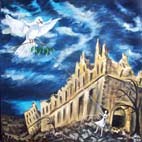Today as I sorted random boxes of older Legato brochures to put into the car (when it stops raining) I was thinking back over the various Legato exhibitions. One that will remain with me a long, long time is the only Legato to be hosted in New Zealand so far. It had been my intention to have one in New Zealand every two years and I was in contact with the Christchurch City Council about holding a South Island edition when the tragic earthquake struck. The Wallace Gallery, in Morrinsville remains the only NZ venue.
So much for my bigger plans - but in that time there have only been two years without a Legato exhibition somewhere - and sometimes there are two in one year when I am invited to show the works in smaller towns liberated by the New Zealand troops. The exhibitions vary in location and scale, but they do keep going. I think that this year will be the 13th edition of Legato and I am really looking forward to having all the big works on display in the same venue. Together I think they will make a very powerful statement.
In 2011 many of the artists who had exhibited in Italy met again, and new artists joined us. For me it was a lovely chance to meet artists in person, and to share more of the story of how the battles for Cassino make Cassino the ideal place to focus on peace work. Josef (Jupp) Klein, the German veteran who established a foundation for remembrance and reconciliation at the same time as Douglas Lyne set up the cooperating Monte Cassino Foundation for Remembrance and Reconciliation (MCFRR) in London, said that there were soldiers of at least 32 different ethnicities fighting on the Gustav Line. Combine this with the intentions of St Benedict, founder of the Abbey that was the central point of the Gustav Line and whose work remains a testimony to peace to this day, and it seems only right that Cassino should at least become a centre for peace work and study.
But back in New Zealand in 2011 we were a long way from the atrocities of war. Please click on this link to the Wallace Gallery, Morrinsville, to see photos from the Legato exhibition held there eight years ago.
So much for my bigger plans - but in that time there have only been two years without a Legato exhibition somewhere - and sometimes there are two in one year when I am invited to show the works in smaller towns liberated by the New Zealand troops. The exhibitions vary in location and scale, but they do keep going. I think that this year will be the 13th edition of Legato and I am really looking forward to having all the big works on display in the same venue. Together I think they will make a very powerful statement.
(Photograph from the Wallace Gallery website)
In 2011 many of the artists who had exhibited in Italy met again, and new artists joined us. For me it was a lovely chance to meet artists in person, and to share more of the story of how the battles for Cassino make Cassino the ideal place to focus on peace work. Josef (Jupp) Klein, the German veteran who established a foundation for remembrance and reconciliation at the same time as Douglas Lyne set up the cooperating Monte Cassino Foundation for Remembrance and Reconciliation (MCFRR) in London, said that there were soldiers of at least 32 different ethnicities fighting on the Gustav Line. Combine this with the intentions of St Benedict, founder of the Abbey that was the central point of the Gustav Line and whose work remains a testimony to peace to this day, and it seems only right that Cassino should at least become a centre for peace work and study.
But back in New Zealand in 2011 we were a long way from the atrocities of war. Please click on this link to the Wallace Gallery, Morrinsville, to see photos from the Legato exhibition held there eight years ago.













No comments:
Post a Comment